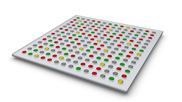Scientists began their studies of genes on a small scale. Typically they would conduct research on single genes, then use their results to hone in on the functions of these genes. Later, newer scientific techniques made it possible for researchers to analyze multiple genes in concert, and eventually to analyze all of an organism's genes at once.
This unit explores some of the ways in which researchers can use modern laboratory techniques to monitor gene transcription, expression, and regulation on small and large scales alike. The unit begins with an explanation of two common processes for determining gene expression — Northern blot analysis and serial analysis of gene expression (SAGE) — both of which allow researchers to measure levels of messenger RNA in a sample, and thereby determine which genes are expressed in the sample and to what degree. Next, the unit examines some of the processes by which researchers have determined the actual sequence of nucleotides within genes. Here, the unit's primary focus is on the technique known as Sanger sequencing, wherein DNA replication is used to detect the presence and arrangement of individual nucleotides.
When studying the function of a particular gene, scientists often need large amounts of the DNA sequence of interest in order to conduct their experiments. Thus, the next portion of this unit describes the sophisticated lab technique called the polymerase chain reaction (PCR), which enables researchers to rapidly generate multiple copies of genetic sequences. Thereafter, the unit describes the creation of a gene deletion model called a knockout mouse. By disabling or "knocking out" specific genes within these mice, researchers are able to uncover a wealth of information about the function of the missing genes. Lastly, the unit concludes with a look at microarray analysis, a technique that makes it possible to screen for vast amounts of genes at once, which permits more efficient examination of an organism's entire genome.
















